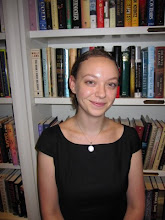It's been mentioned to me before on more than one occasion that my interests in books is, well, eclectic, to say the least. I will read the latest winner of the Pulitzer or the Man Booker prize with gusto and great enjoyment, but I won't turn my nose up at the dog-eared James Patterson book lying around the hotel lobby when I'm on vacation. It's a book! It's a lovely, beautiful, fabulous book, and I want nothing more than to immerse my consciousness in the pages of whatever book is in front of me for an hour or two.
That said, I've come to find out that as wide and diverse and multifarious as my reading list is, my book preferences share a common theme. I like to learn new things. Yes, I am one of Those People -- the ones who read to have their horizons broadened and their minds opened. Whether it's something grounded in reality (such as a new technique for preparing couscous) or entirely fictional (I'm desperately curious as to the other four exceptions to Gamp's Law of Elemental Transfiguration), the new, the novel, the unique, and the unexpected make reading a pleasure that words don't capture adequately.
Find out what I've learned after the jump!
From On Monsters: An Unnatural History of Our Worst Fears, I learned of the origins of mythical beasts -- their roots in fact and fiction, where they were first dreamed into being, which great storytellers gave them life, and how they were viewed by the people of the time. A psittacosaurus of the late Cretaceous era shares a strong likeness with Western civilization's griffin, for example. The monster as a metaphor is examined through the lens of Socrates' lectures and Plato's Republic. Monsters are given religious context as an extension of God's will in the writings of Saint Augustine: "It pleased the Creator to produce them, that it might thus be demonstrated that neither beauty, nor yet size and strength, are of much importance to the wise man." Birth defects are explored through the once prevalent belief that external influences, such as what women touched while conceiving or what they gazed upon while pregnant, held sway over the gestating infant within. "God's blueprint" is called into question by the new science of paleontology in the 1830s. The human monster is touched upon using deviant psychology and psychoanalysis. And modern-day irrational fears of autonomic robots are contrasted with the much more reasonable fears of resourceful hackers manipulating technology against the public with nothing but human ingenuity.
1001 Beers You Must Taste Before You Die taught me that not all beers are created equal. In less than two months since reaching legal drinking age, I've discovered that Kirin Ichiban is smooth and delicious, India Pale Ales are too hoppy for my taste, Fat Tire Amber Ale is malty and bold, #9 is somewhat fruity and goes well with Thai takeaway (and with late night apartment painting), and that I have a strong preference for Irish style red ales. My partner in crime and I have an evening of pizza and beer tasting in our near future, though the particulars of what to try is exceedingly difficult to decide. We've been unable to decide whether to go by category (amber, blond, white, dark, and specialty) or by country (Australia boasts 32, Finland 3, Israel 1, the United States 243). This book comes out at the end of March, so have patience, beer enthusiasts. It is well worth the wait.
From Larousse Gastronomique I have learned everything. I am replete with knowledge of ingredients, equipment, techniques, customs, and recipes. I know what an alcazar is and how to cook it (it's a gateau made with apricot marmalade and almond meringue), I can identify 15 different cuts of beef; I know the stages in the cheesemaking process and the classification of the types of cheeses; I know that gastrique is a reduction of vinegar and sugar, and not a fancy new spelling of gastric; I know recipes for both sweet and savory mousses; I know the difference between ras el hanout and rassoinick; I learned there really is such a thing as a snipe (and they are hunted). This book is a culinary bible. It is an epicurean encyclopedia. It is the most marvelous thing I've ever been lucky enough to have in my kitchen. It will take me years -- decades, even -- to try every recipe and technique in Larousse Gastronomique, and by the time I'm finished I'll need to start all over again, just to make sure I haven't forgotten anything.
The Physics of Superheroes has taught me that if my high school math and science teachers had been as cool as James Kakalios, I might have ended up a physics major. Well, that might be a slight hyperbole, but only just. I'd certainly not have loathed either subject so virulently, not when the instructor is busy making jokes about pulp fiction writers, pinpointing when Superman gained free will over the laws of physics, and determining how the Flash can run up the sides of buildings by accelerating in both a vertical and horizontal direction. I learned the role that negative energy plays in Dr. Pym's shrinking solution, why Aquaman is as strong (if not stronger) than Superman, that the Owlship from Watchmen would have required over 180,000 gallons of gasoline to get from New York to Antarctica. There is no escaping that I have a soft spot for comic books, and seeing how the Second Law of Thermodynamics applies to X-Men's Bobby Drake only makes things more interesting.
Q&A …
3 hours ago




No comments:
Post a Comment